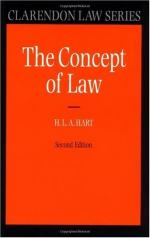
|
| Name: _________________________ | Period: ___________________ |
This test consists of 15 multiple choice questions and 5 short answer questions.
Multiple Choice Questions
1. What are our legal standard, according to Hart?
(a) Good.
(b) Indeterminate.
(c) Determinate.
(d) Imperfect.
2. What are the ultimate rules?
(a) Internal Statement.
(b) Customs that make it into laws.
(c) The final test of validity.
(d) Moral based laws.
3. What do secondary rules track?
(a) The multiple aspect.
(b) The external aspect.
(c) The internal aspect.
(d) The simple aspect.
4. What is is caught between the poles of excessive formalism and excessive rule-skepticism?
(a) Legal theory.
(b) Custom.
(c) Moral rules.
(d) Judges.
5. What do moral rules vary across?
(a) Country.
(b) People.
(c) Societies and time periods.
(d) Lands.
6. What does Hart wonder about international law?
(a) If it is doomed to fail.
(b) Is it applicable.
(c) If it is necessary.
(d) It is law at all.
7. What does Hart oppose to legal rules?
(a) Judicial precendent.
(b) Custom rules.
(c) Moral rules.
(d) Religious rules.
8. Why do moral codes exist?
(a) To prevent people from expressing themself.
(b) To ensure proper obedience to the ones in charge.
(c) To promote the good of the society.
(d) To ensure tight moral standards.
9. What can the official sector be in conflict with?
(a) Private sector.
(b) Customs.
(c) The people.
(d) Lawmakers.
10. What does International law threatens according to Chapter 10?
(a) Local judges.
(b) The account of law previously developed.
(c) National independence.
(d) Smaller countries.
11. How many connections between morality and law does Hart discuss?
(a) 6.
(b) 4.
(c) 2.
(d) 5.
12. What does the law need not be determined by?
(a) Judges.
(b) The meaning of the words.
(c) Independent lawmakers.
(d) Elected officials.
13. What can statement of law made as?
(a) Simple or complexe.
(b) Singular or multiple.
(c) Low or high.
(d) Internal or external statement.
14. How are international laws and morality tied?
(a) In complex ways.
(b) Though customs.
(c) Though morale.
(d) In Simple ways.
15. What standard do we often try to employ, according to Hart?
(a) Efficiency.
(b) Fairness.
(c) Reasonableness.
(d) Speed.
Short Answer Questions
1. Who would have different view of justice ?
2. What are authoritative quality of general rules sometime qualified as?
3. What do we make relative to the interpretation of rules?
4. What is used to blame people who offend on morality?
5. What can the ultimate rule of recognition be recognized from?
|
This section contains 366 words (approx. 2 pages at 300 words per page) |

|




